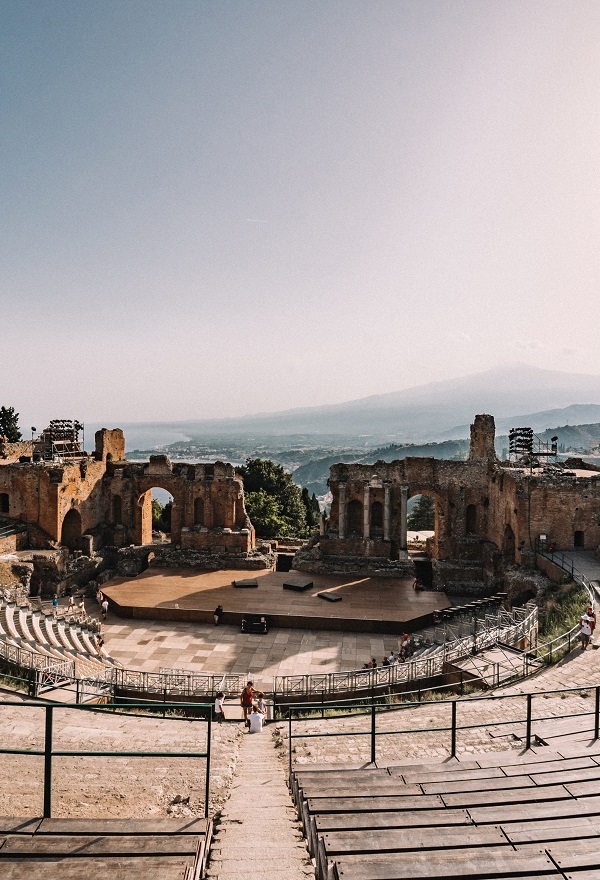Taormina

The Ancient Theatre of Taormina

Isola Bella

Taormina

The Ancient Theatre of Taormina

Isola Bella

Ancient Theatre

Taormina’s premier sight is this perfect horseshoe-shaped theatre, suspended between sea and sky, with Mt Etna looming on the southern horizon. Built in the 3rd century BC, it’s the most dramatically situated Greek theatre in the world and the second largest in Sicily (after Siracusa). In summer, it’s used to stage concerts and festival events. To avoid the high-season crowds, try to visit early in the morning.
Duomo

Located in the Borgo Medievale, the oldest quarter of town, on the eastern side of Piazza del Duomo, there is the 13th-century cathedral. It survived much of the Renaissance-style remodelling undertaken throughout the town by the Spanish aristocracy in the 15th century.
Villa Comunale

Created by Englishwoman Florence Trevelyan in the late 19th century, these stunningly sited public gardens offer breathtaking views of the coast and Mt Etna. They’re a wonderful place to escape the crowds, with tropical plants and delicate flowers punctuated by whimsical follies. You’ll also find a children’s play area.
Palazzo Duca di Santo Stefano

Just behind Corso Umberto and near Porta Catania, this 13th-century palace was once home to the De Spuches, a noble family of Spanish origin. Now used as a functions space, its Norman Gothic windows and Arab accents make it one of Taormina’s architectural pin-ups.
Porta Messina

Porta Messina was originally named Porta Ferdinanda when opened by Ferdinand IV of Bourbon in 1808. The occasion is commemorated in the plaque above the gateway’s arch.
Santuario Madonna della Rocca

Built inside a grotto on Monte Tauro, this small church was founded by the abbot Francesco Raineri in around 1640. According to legend, the Virgin Mary and baby Jesus appeared to a young shepherd who had taken refuge in the grotto during a sudden storm. The lofty view from the church’s terrace is almost as heavenly, taking in Taormina, Giardini Naxos and the deep-blue Ionian Sea beyond.
LOCAL ATTRACTIONS
Situated on central Taormina, just a stone’s throw from Corso Umberto and Piazza IX Aprile, The Ashbee Hotel is a perfect base for you to see all that Taormina has to offer.
Corso Umberto I

Taormina’s chief delight is wandering this pedestrian-friendly, boutique-lined thoroughfare. Start at the tourist office in Palazzo Corvaja, which dates back to the 10th century, before heading southwest for spectacular panoramic views from Piazza IX Aprile. Facing the square is the early-18th-century Chiesa di San Giuseppe. Continue west through the Torre dell’Orologio, the 12th-century clock tower, into Piazza del Duomo, home to an ornate baroque fountain (1635) that sports Taormina’s symbol, a two-legged centaur with the bust of a woman.
Monte Tauro

The short climb to the top of Monte Tauro (378 mt) is not exactly Himalayan, but it is steep and the final steps are quite hard work. Your reward is a breathtaking panoramic view over Taormina’s rooftops, the Teatro Greco and, beyond, to the coast.
Chiesa di San Giuseppe

Overlooking Piazza IX Aprile, this jewel-box church was completed in the early 18th century. The central portal is made of local marble while the portals on either side of it consist of Syracuse stone. Inside, the single-nave interior is decorated with whimsical rococo stuccowork featuring floral motifs and cherubs. The main altar is made using local marble while the fresco adorning the dome depicts a young San Giovanni Bosco between Christ and the Virgin Mary.
Torre dell'Orologio

Located just west of the main square, Piazza IX Aprile, this 12th-century clock tower marks the entrance to Borgo Medievale, Taormina’s oldest quarter.
Isola Bella

Southwest of Mazzarò is the tiny Isola Bella, a beautiful nature reserve set in a stunning cove with fishing boats. Reached on foot via a narrow sandbar (take your shoes off), the island was once home to Englishwoman Florence Trevelyan, creator of Taormina’s Villa Comunale.
Saracen Castle

Perched atop Monte Tauro are the (inaccessible) ruins of this castle, built between the 11th and 12th centuries. The castle sits on the former site of Taormina’s ancient Greek acropolis.
PLAN YOUR VISITS NOW
Whatever you need and whenever you need it, simply ask.
Call us (0039) 0942 23537 or contact our Concierge Team online here.
Our guests are the heart of our hotel.
Sicily
Exciting and Unmissable Day Trips from Taormina
Find Out MoreHow to Reach Us
The best ways to reach The Ashbee Hotel
Find Out MoreGet the latest offers
Sign up for our newsletter
Viale San Pancrazio 46,
98039 Taormina (ME), Italy
+39 0942 23537

LUXURY PRIVATE PROPERTIES GROUP Copyright © 2021 – Società Immobiliare ed Alberghiera Srl Via Ugo Bassi 28 – 98123 Messina (ME) C.F. & P.IVA: 02827370830 – Registro delle Imprese di Messina – N. Rea ME-195462 Cap. Soc. €2.500.000,00 interamente versato






